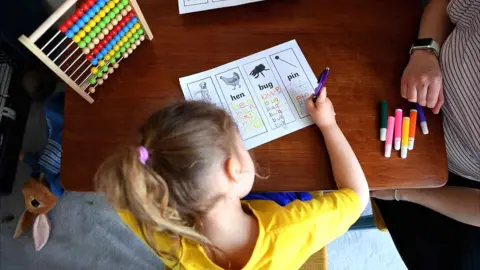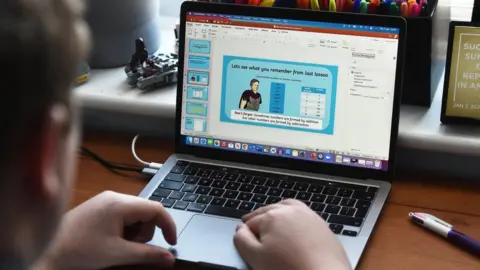School attendance in England higher than first lockdown
 Getty Images
Getty ImagesSchool attendance in England is five times higher than during the first lockdown, official figures show.
One in five (21%) primary school pupils and one in 20 (5%) secondary school pupils went into school last week, the Department for Education reports.
Only 4% of state primary school pupils and 1% from state secondaries were in school during closures last year.
The increase has been driven in part by children without laptops or tablets being allowed to attend school.
Around 1.1m students attended school last week, of which roughly three-quarters were children of critical workers, the DfE data shows.
Pupils in schools and colleges in England - except children of key workers and vulnerable pupils - have been told to learn remotely until at least mid-February due to tighter restrictions over Covid-19.
But more schools are teaching children of key workers and vulnerable children on site than during school closures in the first lockdown.
On 13 January, 99% of state-funded schools were doing in-person classes - compared to 80% in May 2020.
The definition of vulnerable children has also been expanded to include pupils who do not have laptops, allowing them to access face-to-face learning at school.
Geoff Barton, general secretary of the Association of Schools and Colleges, said schools were "under tremendous pressure" as they juggled pupils learning in school and online.
He said the figures "also raised concerns about how many children it is safe to have in schools during a time in which the Prime Minister has advised people to stay at home and save lives".
Laptops and tablets
The government has pledged to provide 1.3m devices to schools and councils at a cost of £400m but only 801,324 devices had been dispatched or delivered by 17 January.
Nearly 240,000 devices have been delivered since the start of the new year, with an additional 20,000 being sent out every day, according to the DfE.
Education secretary Gavin Williamson said he was proud to see hundreds of thousands of devices delivered to schools and councils.
"I know that teachers, school staff and parents have continued to work collaboratively and immensely hard since the start of this term to help children to learn at home," said Mr Williamson.
"It is absolutely vital that we get devices out to children who need them the most."
The government is also providing 4G wireless routers to help families with limited internet access.
 Getty Images
Getty ImagesAnne Longfield, Children's Commissioner for England, welcomed the "progress in the distribution of laptops" but added "there are many children who are still not able to learn from home properly".
But shadow schools minister Wes Streeting renewed calls for the education secretary to resign, saying "getting every child online should have been a national priority, but instead it's been an afterthought for Gavin Williamson."
Laptops and tablets are being offered to disadvantaged children in Years 3 to 11.
The local authorities that have received the most laptops are:
- Tower Hamlets: 19 laptops per 100 pupils (Years 3-11)
- Liverpool: 17 laptops per 100 pupils
- South Tyneside: 16.8 laptops per 100 pupils.
Rob Carpenter, chief executive of Inspire Partnership Academy Trust, which runs nine primary schools with over 4,200 pupils across south east London and Kent, told BBC News there were "still at least 500 children across the trust who need devices".
"Five hundred and thirty-five tablets and computers have been delivered by the government but we need more," said Mr Carpenter.
"Our pupils face a lack of actual devices, problems with internet access and parents struggling with setting up the technology."
Inspire Partnership Academy Trust has seen attendance as high as 30% in recent weeks as a result.
Mr Carpenter said he worried the shortfall in laptops and problems with internet access "would only further the attainment gap between better-off and less well-off children".
According to the Office for National Statistics, only 51% of households earning £6,000-£10,000 have home internet access, compared with 99% of households with an income of more than £40,000.
